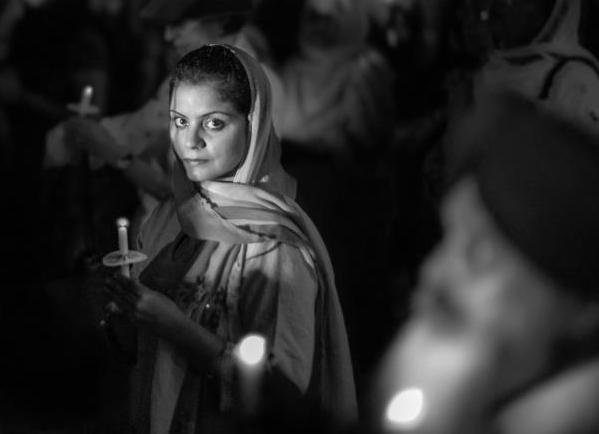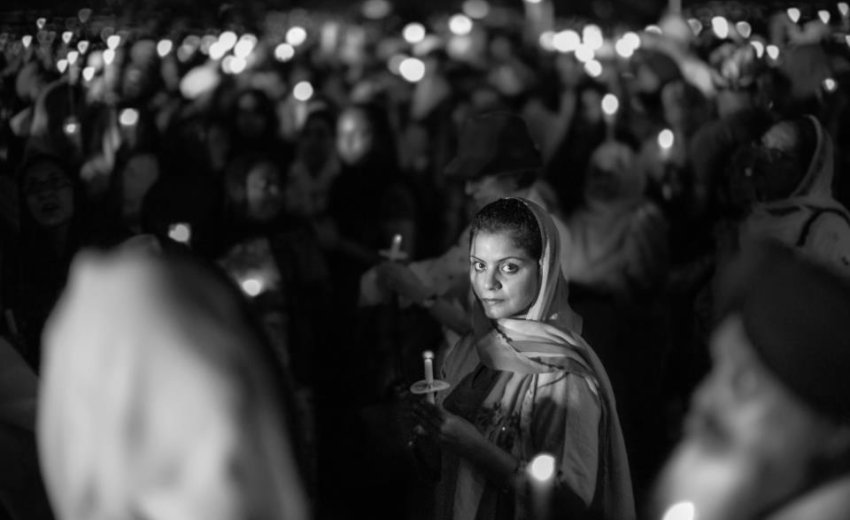More than 300 years of continuous history speaks of Sikh men as bearded long-haired creatures but it hardly mentions any visible markers for Sikh women. Since it does not easily distinguish them from the millions of non-Sikh women in the world it often leaves them out of the mainstream thinking and ideas of Sikhi. Out of thinking; out of reckoning.
 |
| A Sikh woman attends a vigil last Wednesday night in San Jose, California in honor of the victims of the Wisconsin Gurdwara shooting. (source: Karaminder Ghuman) |
Over the years I thought about this often and have even written bits and pieces about it but not exclusively and not at length. Now a recent sensitive and introspective essay “A Kaur Identity Crisis” on SikhNet by Lakhpreet reopens many issues; hence this piece today which revisits my own thoughts and opinions.
It is time these matters were re-explored and examined threadbare. Keep that in mind as you peruse this: that mine is a male point of view but, hopefully not a biased or bigoted one.
We don’t need to step far back into prehistoric times to see the world as we know it. Over the years things have changed in matters of gender sensitivity but neither enough, nor willingly, and just as much as ever remains to be done.
In the United States, for instance, women’s right to vote came after a historic struggle and only as recently as 1920, fully 150 years after the country was founded on principlesof liberty, equality and the pursuit of happiness. Witness the unequal pay that many women still make in the corporate workplace. Even so, this is way better than much of the world where women have neither a voice in citizenship nor any right to honest work or fair pay.
We know how society saw women when the Gurus trod the Earth 500 years ago. In the India of that time the right of a widow to remarry did not exist. She was expected to immolate herself on the funeral pyre of her dead husband. A regressive dowry system and the killing of female children at birth were widespread. Women were forbidden to read the Hindu scriptures; but they did exist as vestal virgins and dancing girls within the temples.
Sikh teaching rejects all this. We remember, and endlessly quote to others, the challenging response from the Guru Granth. I will not repeat the whole composition on women that we hear every morning as part of Aasa-di-Vaar (p 474) that goes thus:
Bhand Jamiyae bhand nimiyae bhand mangan viaho; bhando hovay dosti bhando chalay rahu…
In translation:
Of a woman we are conceived; of a woman we are born.
To woman we are betrothed and married; a woman is friend and partner for life.
It is a woman who keeps the race going; another is sought when the life partner dies,
Through woman are established social ties.
From woman alone is born a woman; without woman there is no human birth.
Without woman, O’ Nanak, only the True one exists.
The message penetrates, but it remains only skin deep. It becomes a powerful opportunity to preach how far ahead of their times the Gurus were. That is true. But that’s as far as it goes.
Most of us crow about the equal place that women are accorded in Sikhi but seldom admit that within our culture they were, and still remain, the lesser gender.
This dissonance – the dichotomy between our belief and practice -- hit me almost 20 years ago when I was writing an essay on gender issues for a book and a young lady asked me why not even one of the first five Sikhs initiated as the Khalsa in 1699 was a woman. Don’t forget that each of the ten Founder-Gurus during the two centuries of the Guru period, too, was a male; no women there either.
From that conversation we worked out a plausible way out of this direct challenge by pointing out the folklore and history that as many as 80,000 people may have gathered at Anandpur in 1699 when Guru Gobind Singh, the Tenth master, with a naked sword in hand, issued a call for a head. Can you imagine the consternation; surely there were no PA systems and microphones at hand over 300 years ago. If this crowd had to be fed who do you think were cooking and feeding the assembly if not the women? And if there were small children who were they clambering on if not their mothers? In the Indian culture at that time, and even today, when people sit on the floor in large assemblies men and women are somewhat segregated. It is likely that the women perhaps never even heard the call.
Keep in mind also that Sikhs exist as barely a small drop in the large bucket of non-Sikh population of India where Sikhi arose. This is so, even though there are close to 25 million Sikhs that form the fifth largest religion in the world; but there are over a billion people that make up modern India. Granted that India has produced a woman head of government but familial and societal values have not really changed all that much.
In the traditional Hindu society which is almost 80 percent of India’s burgeoning population, according to the Hindu law giver Manu’s Code of Conduct, a woman was barred from access to scriptures and her place was a bit lower than that of a cow.
The former U.S. Ambassador to India, John Kenneth Galbraith opined that anything that goes to India, even industry, gets Hinduized. It’s no wonder then that the traditional Hindu caste system has penetrated into all existing religions in India, including Islam, Christianity and Sikhi.
Additionally, dehumanizing realities in all religions extant in India include female foeticide and the evils of the dowry system. Despite clear admonition in Sikhi against both, even today dowry and female foeticide cast a long shadow in Sikh society as well.
The final nail in the coffin of gender issues in Sikhi comes from my reading of the Sikh Code of Conduct (Sikh Rehat Maryada) that was formally codified only in the mid-twentieth century. It has an intriguing clause that requires “a Sikh father to marry his daughter to a Sikh” but sets forth no dicta regarding marrying a son to a Sikh or non-Sikh bride.
A quick reading makes the blood boil at this seemingly rank injustice against women, for it limits a young woman’s choices of a marriage partner but not a young man’s.
Again a closer look at the culture that existed in India centuries ago, is prevalent today and was equally endemic sixty years ago when the Rehat Maryada was finalized, would help.
The custom I am talking about is that of arranged marriages where the bride at marriage joins the household of her husband, which was usually a joint family model. Often a bride’s contact with her own biological family became minimized after her marriage and sometimes even her given name was changed by the “in-laws.” In such a familial arrangement, if the husband and his family were deeply religious, the new bride became so herself; if they followed certain special or mixed practices, she adopted them too; if they were lax in their belief, so would she become.
Ergo, it becomes critical that a young woman should marry an observant Sikh so that she, too, would retain Sikhi and then so would her children. A provision on who a son should marry was unnecessary because no matter whom he married, his wife would come to adopt his religious ways, if there were any.
When I reason thus I see that the language of the Rehat Maryada is not necessarily sexist but just markedly arcane and outdated; it needs rewriting to make for clarity.
I cite here an extract from Lakhpreet’s “A Kaur Identity Crisis” that I referred to at the beginning of this column today. (Remember this: In Sikh teaching Singhs are male and Kaurs are female; dhari or, better yet, darhi is beard while dastar is turban.). Lakhpreet says:
“The physical identity of Singhs is quite simple. Either he keeps his dhari and wears a dastar, or he doesn’t. There are a few combinations of those options, such as wearing dastar but not having a dhari and vice versa, but in general, the visual portrayal of the Sikh male is standard and universal.
The Kaur physical identity, however, is not so obvious or well defined. Some Kaurs keep kesh, others do not. Some cover their heads with dastars, patkas, or chunis, while others choose not to cover their heads. Some Kaurs believe it is okay to try different hairstyles, while others stick to one.
At this point in time, Sikhi does not have a collective, communal idea of what a Kaur looks like or what her physical identity should portray. This begs the question: Are Kaurs, as a collective, suffering from a physical identity crisis?” (Emphasis mine.)
Lakhpreet makes an excellent point here. It is obvious that, irrespective of
how many, or how well, Sikhs follow or do not follow the guidelines of the Sikh
Code of Conduct, a male Sikh’s personal and communal persona is well known and accepted;
but in the case of Sikh women there seem to be no clear guidelines at all. I
understand that in every religion many adherents always carry a somewhat fluid
identity but I don’t see quite the gender gap and dichotomy that we see between
Sikh men and women in their public and communal persona.
This piece today is not to argue for greater or lesser fluid identity for men or women. It is to explore why and how greater fluidity for Sikh women may have evolved in an India that has always been restrictive of women, and oddly, in Sikh society as well, where the teachings are purposefully focused on gender equality.
That woman is the lesser gender even today is beyond debate. And that’s not the question. Today I merely offer plausible hypotheses of how such practices very likely took birth; I absolutely DO NOT offer them bearing my stamp of approval-- my imprimatur, so to say.
I sometimes think of women in our religion as the invisible half. Most, if not all, of us will insist that the blinders with which we operate in life are cultural and do not stem from Sikh doctrine or teachings. The question then is why do we not change things? We have changed some realities – in our parents generation, women were generally educated, but not very much. Very few pursued careers. Now matters are increasingly different.
I know what cultural and social norms dictated in the past. Times have changed but our cultural shackles remain. When gurdwara management is decided, it is 99.99% men. Good heavens, we won’t even let women perform keertan on a regular basis, and in some gurdwaras never. But they can cook langar for zillions.
The role of women in our home and communal life should be such that no gender difference is apparent and their prominence in gurdwara or society raises neither eyebrows nor applause – in a truly egalitarian society, that we say the Gurus founded, this should be an ordinary matter in the course of things.
We have two choices as we talk about this issue: We can debate it and lament it until the cows come home, as we have done before -- or we can change it starting with our own homes and gurdwaras. And don’t point to Indira Gandhi, Golda Meir, Margaret Thatcher or Rani Jindan; they were outliers.
History tells us about Sikh women like Rani Jindan and Mai Bhag Kaur or Mata Sahib Devan. But look at the published record about them and it is no more than a couple of inches of print.
Have we not, in fact, written women out of our history?
Should women really have no place in our memories and no role in shaping our spiritual lives?
Cultural norms only harden over time and then dislodging them requires a Herculean effort and then some. If we do not undertake this effort, they become a Gordian knot that may be cut but not unraveled. Our cultural blinders were not meant to become booby traps or land mines but that’s what they now are.
That’s where we are at this time. What we do is up to us, isn’t it?
December 1, 2013

